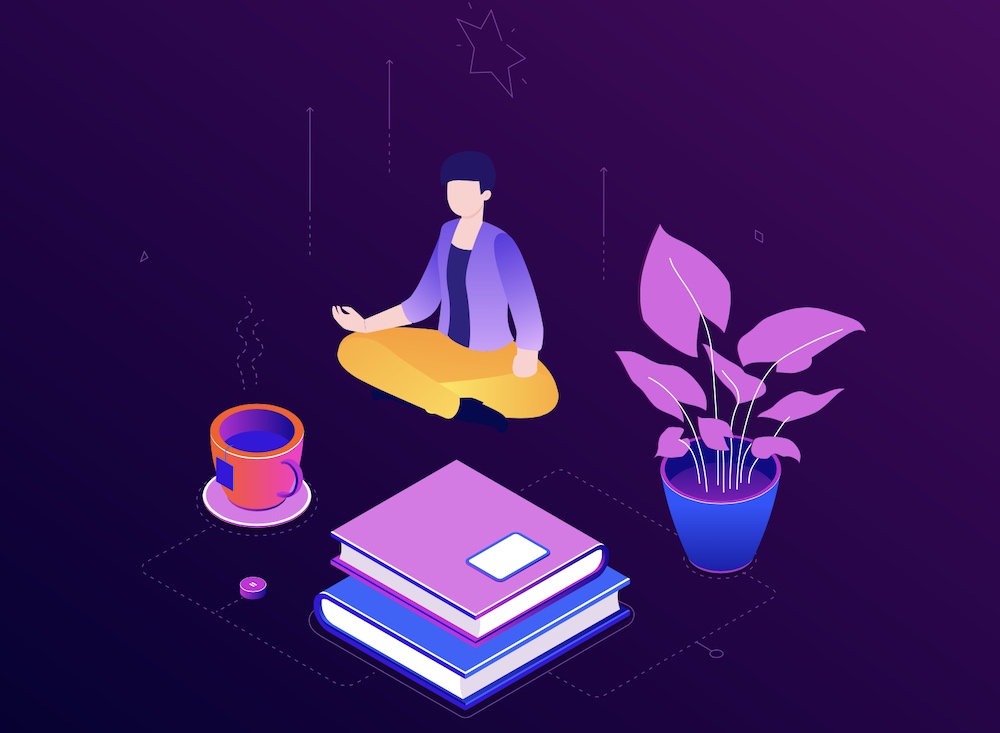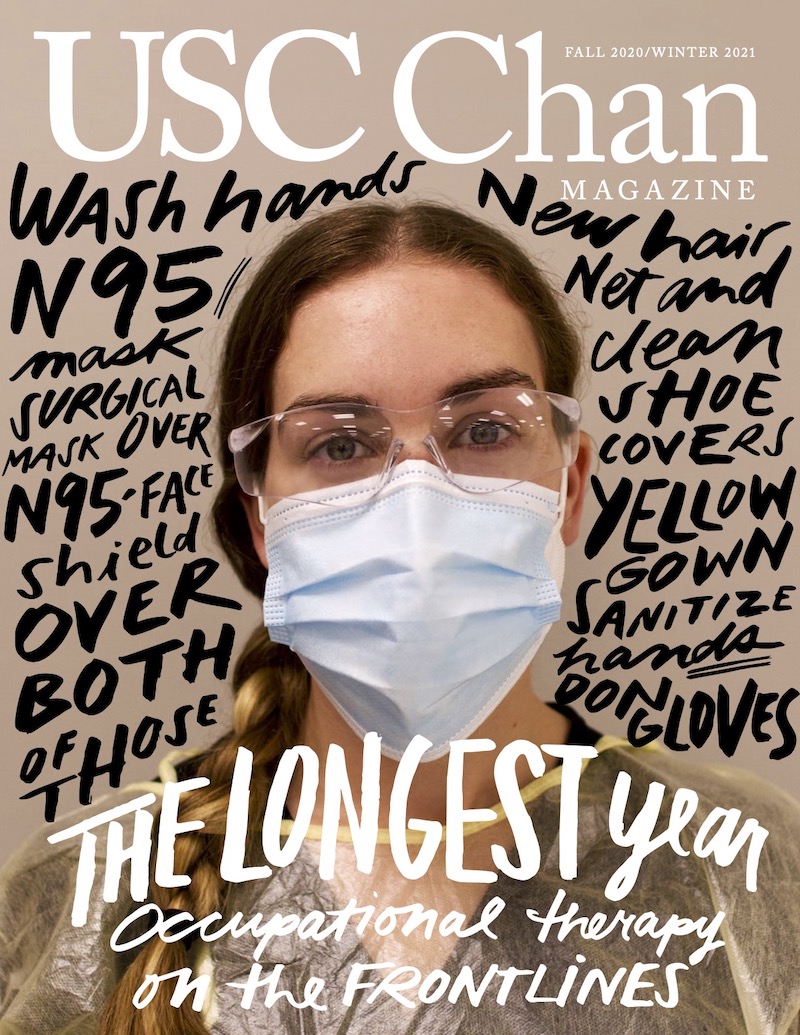Pain and Pleasure
Face to face and through the screen, a USC occupational therapist helps a client better manage her everyday pain to improve quality of life.
By Jamie Wetherbe MA ’04
Five years ago, Kim Michalski, now 67, had a prominent career as an investment manager, overseeing portfolios for high-wealth clients and traveling across the country to manage her own staff.
But behind closed doors, Michalski was experiencing excruciating sciatic pain and spinal degeneration.
“Carrying suitcases and briefcases, even walking, was becoming a challenge,” she says. “I could barely read my own handwriting. I would be at my desk, close the door and hang my head, and try to get through it.”
In 2016, when Michalski was 63, the pain grew to the point that she had to go on disability. “It was hard giving it up because I loved what I did, but I could no longer do it well,” she says. “I wish I had known some of the techniques I use now back then.”
Michalski is a patient of the USC Occupational Therapy Faculty Practice, which offers an occupational therapy intervention called Lifestyle Redesign, focused on helping people “redesign” daily habits to improve their health and wellness. The program starts with a detailed exploration of a series of factors, including how a patient eats, sleeps, exercises and manages stress, as well as the safety of their home and routines.
“Then we find the windows of opportunity to tweak things and improve your ability to manage your condition and quality of life,” says Erin “Malia” Sako, Michalski’s occupational therapist and assistant clinical professor at USC Chan.
A new lease on lifestyle
After seeing a number of medical specialists to get to the bottom of her pain, Michalski was diagnosed with rheumatoid arthritis; small fiber neuropathy; Mast Cell Activation Syndrome, which affects the body’s histamine responses; and Postural Orthostatic Tachycardia Syndrome, a blood circulation disorder. She connected with a team of experts at Keck Medicine of USC, and in 2019, was referred to Sako.
“That started this wonderful journey on how to manage my life within the challenges I’ve been facing,” Michalski says. “As my [conditions] have gotten more complicated, Malia’s been able to provide me with tips and skills. She has been wonderful and tough; she doesn’t let me backslide, and holds me accountable.”

Lifestyle Redesign’s innovative and highly individualized approach helps patients manage their conditions through collaboration and problem-solving, as well as setting realistic goals and expectations.
“If someone is coming in fresh with a diagnosis, like MS or Parkinson’s, we can be a source of education and a space for learning and self-analysis,” Sako says. “We go through a lot of really tough mental and emotional work to figure out a patient’s barriers to living a health-promoting life.”
Lifestyle Redesign is also appropriate for people further along in their health journey. An important piece of the program is ensuring that new habits and strategies are sustainable over time.
“I tell a lot of my patients, I’m not looking for them to have a really great month,” Sako explains. “I’m looking for them to have the confidence and self-efficacy to integrate these strategies and education in a feasible and consistent way.”
From making medications more accessible, to rearranging furniture and rugs, Sako helped Michalski adjust her home and habits to make life just a bit easier.
“I was resistant, initially,” Michalski says. “I was thinking, ‘I have to change all of that?’ But it’s helped immensely.”
Even the way that Michalski wakes up in the morning was re-choreographed to minimize discomfort.
“I have a stool at the side of the bed, so my feet land on that instead of hitting the floor, which causes pain up my back,” she explains.
So much of Lifestyle Redesign also focuses on making mental adjustments.
“I was still very independent,” Michalski says. “Malia had to teach me how to ask for help — with groceries, moving heavy things, cleaning — that was a big thing.”
“[Malia] calls me a ‘completer’ — I can’t leave things undone,” Michalski continues. “But that pushes me too hard, and I exhaust myself and put myself into more pain.”
Michalski learned to better manage her energy by taking breaks throughout the day, even splitting up recipes in order to cook favorite foods more efficiently.
“It helped me learn to pace myself and prioritize,” says Michalski. “I’ve discovered it makes me more productive.”
In addition to managing energy, Michalski learned other tricks and tools to manage her pain, including breathing exercises and practicing tai chi with the help of short YouTube videos.
“The small movements with the breathing have been the best tonic,” she says.
Time to pause
After about four months, Michalski completed her first round of Lifestyle Redesign in early 2020. But then came the coronavirus. As lifestyle changes related to the pandemic started to impact her pain, Michalski came back to Sako for an “OT tune-up.”
During their hour-long sessions, this time via telehealth conversations, Sako and Michalski worked on integrating a walker and other new adaptive devices into her routine, as well as improving eating and sleeping habits.
“I was having a lot of problems, and I needed help to get me back on track,” Michalski says. “The good thing about the program is it’s always there when you need it.”
For many of Sako’s patients, the unimaginable challenges posed by the pandemic have proven to be health-deterring. But for others like Michalski, that abrupt disruption caused by the pandemic has acted as an unexpectedly beneficial reset.
“I’ve heard a lot of people say, ‘If I were out and working, I would never have time to do this.’ Like with Kim, it’s been a time to pause and prioritize their health — that’s been a really good thing.”
Still, it’s been Michalski’s commitment to her own wellness journey, online and in person, that has been essential to her progress.
“I think her engagement in the process has been key, especially in this transition into telehealth,” Sako says. “Kim’s just a delight to work with, and open to talking about any lifestyle topic. I think that openness has been a huge part of her success in our work together.”
Learn more about Lifestyle Redesign programs at chan.usc.edu/otfp.
⋯







